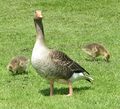Greylag Goose
| Greylag Goose | |
|---|---|
 |
|
| Western Greylag Goose (Anser anser anser) | |
| Conservation status | |
| Scientific classification | |
| Kingdom: | Animalia |
| Phylum: | Chordata |
| Class: | Aves |
| Order: | Anseriformes |
| Family: | Anatidae |
| Genus: | Anser |
| Species: | A. anser |
| Binomial name | |
| Anser anser (Linnaeus, 1758) |
|
| Subspecies | |
The Greylag Goose (also spelled Graylag in the United States), Anser anser, is a bird with a wide range in the Old World. It is the type species of the genus Anser.
It was in pre-Linnean times known as the Wild Goose ("Anser ferus"). This species is the ancestor of domesticated geese in Europe and North America. Flocks of feral birds derived from domesticated birds are widespread.
The Greylag Goose is one of the species to which the Agreement on the Conservation of African-Eurasian Migratory Waterbirds (AEWA) applies.
Within science, the greylag goose is most notable as being the bird with which the ethologist Konrad Lorenz first did his major studying into the behavioural phenomenon of imprinting.
Contents |
Description
_in_flight_1700.jpg)
The Greylag is the largest and bulkiest of the grey Anser geese. It has a rotund, bulky body, a thick and long neck, and a large head and bill. It has pink legs and feet, and an orange or pink bill.[2] It is 75 to 90 centimetres (30 to 35 in) long with a wing length of 41.2 to 48 centimetres (16.2 to 19 in). It has a tail 6.2 to 6.9 centimetres (2.4 to 2.7 in), a bill 6.4 to 6.9 centimetres (2.5 to 2.7 in) long, and a tarsus 7.1 to 9.3 centimetres (2.8 to 3.7 in). It weighs 2,921 to 3,612 grams (103.0 to 127.4 oz). Males are generally larger than females, more so in the eastern subspecies rubirostris.[2]
The plumage of the Greylag Goose is greyish-brown, with a darker head and paler belly with variable black spots. Its plumage is patterned by the pale fringes of its feathers. It has a white line bordering its upper flanks. Its coverts are lightly coloured, contrasting with its darker flight feathers. Juveniles differ mostly in their lack of a black-speckled belly.[2][3]
It has a loud cackling call, kiYAAA-ga-ga, like the domestic goose.[2]
Distribution and habitat
This species is found throughout the Old World, apparently breeding where suitable localities are to be found in many European countries, although it no longer breeds in southwestern Europe. Eastwards it extends across Asia to China. In North America there are both feral domestic geese, which are similar to greylags, and occasional vagrants.[3]
In Great Britain their numbers have declined as a breeding bird, retreating north to breed wild only in the Outer Hebrides and the northern mainland of Scotland. However during the 20th century, feral populations have been established elsewhere, and they have now re-colonised much of England. The breeding habitat is a variety of wetlands including marshes, lakes, and damp heather moors.
In Norway, the number of greylag geese is estimated to have increased three- to fivefold during the last 15–20 years. As a consequence, farmers' problems caused by goose grazing on farmland has increased considerably. This problem is also evident for the pink-footed goose.
Behaviour
The geese are migratory, moving south or west in winter, but Scottish breeders, some other populations in northwestern Europe, and feral flocks are largely resident. This species is one of the last to migrate, and the "lag" portion of its name is said to derive from this lagging behind other geese.[4]
Gallery
 |
.jpg) |
||
.jpg) |
 |
 |
 |
 A Greylag Goose in St James's Park, London, England in May 2006 |
.jpg) A Greylag Googe mugshot taken at the Rhine in Bonn, Germany |
A pair of Greylag Geese by a Pentland Hills reservoir, Scotland. |
 |
|
|
 Greylag in Michigan 2/2/2008 |
Probably hybrid with Domestic Goose: note bulky head and neck with vestigial pattern. |
References
- ↑ BirdLife International 2009
- ↑ 2.0 2.1 2.2 2.3 Madge & Burn 1988, pp. 140–141
- ↑ 3.0 3.1 Johnsgard 2010, p. 60
- ↑ American Heritage Dictionary, graylag, noun.
Literature cited
- BirdLife International (2009). "Anser anser". 2009.2 IUCN Red List of Threatened Species. http://www.iucnredlist.org/apps/redlist/details/141447/0.
- Johnsgard, Paul A. (2010) [1978]. Ducks, Geese, and Swans of the World (revised online ed.). Lincoln, Nebraska: University of Nebraska Press. http://digitalcommons.unl.edu/biosciducksgeeseswans/5/.
- Lorenz, Konrad Z.; Martys, Michael; Tipler, Angelika (1991). Here Am I—Where Are You? The Behavior of the Greylag Goose. translated by Robert D. Martin. Orlando, Florida: Harcourt Brace Jovanovich. ISBN 0-15-140046-3.
- Madge, Steve; Burn, Hilary (1988). Waterfowl: an Identification Guide to the Ducks, Geese, and Swans of the World. Boston: Houghton Mifflin. ISBN 0-395-46727-6.
External links
- RSPB A to Z of UK Birds
- Greylag Goose videos, photos & sounds on the Internet Bird Collection
- Confusing Domestic Geese - An article about Greylag geese in North America, with photos
- the Greylag Goose in the Oostvaardersplassen - An article about the Greylag Goose population in nature reserve Oostvaardersplassen, the Netherlands
- Greylag Goose pictures Wildlife Greylag Goose photos- adult with nestlings and voice
- Strong increase in the number of greylag goose in Norway (PDF, in Norwegian, by the Norwegian Institute for Nature Research)


